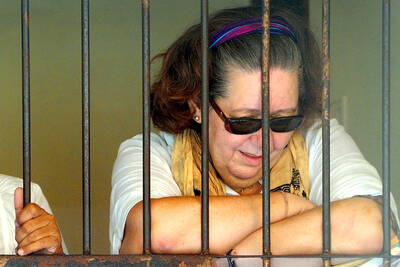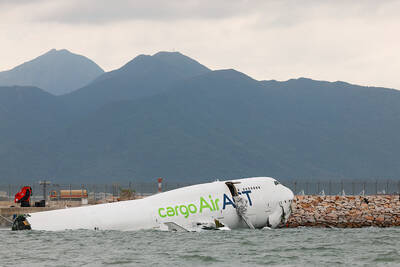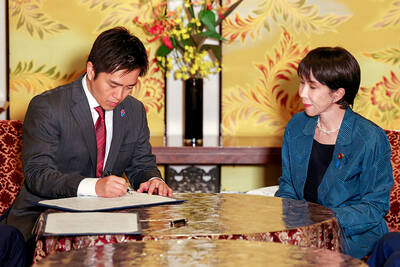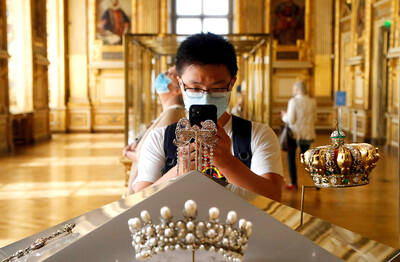For Tashi Choezom, a Tibetan studying for a nursing degree in New Delhi, the string of suicides by Tibetan monks who have set themselves on fire to protest Chinese religious repression are a sin.
“I express my solidarity with those who have committed self-immolation, but it is terribly wrong to take one’s own life,” Choezom said at a recent demonstration by exiled Tibetans.
Yesterday, a Tibetan nun burnt herself to death in southwest China, Xinhua reported, becoming the 11th Tibetan this year known to have set themselves on fire.
Qiu Xiang, 35, set herself on fire at a road crossing in Sichuan Province, Xinhua said, citing the local government.
The nine Buddhist monks and two nuns who have set themselves ablaze this year — chanting for religious freedom and the return of the Dalai Lama to his homeland — have brought international attention once more to the Tibetan campaign.
“We are getting support from various countries through this, but these acts of self-immolation must stop. Buddhism does not allow this,” said Choezom, who has never been to Tibet.
The protests began in March when a 21-year-old monk called Phuntsog set himself on fire at the influential Kirti monastery in Si-chuan, which borders Tibet and has a large Tibetan population. At least another six have died since then, and their actions mark a new phase in resistance to Chinese rule.
However, they have also divided opinion in the exile community: Some feel the ends justify the means, others are staunchly opposed to suicide or attempted suicide on religious grounds.
A culture of self-censorship because of heavy Chinese security and restrictions placed on reporters in the remote Himalayan province make measuring opinion inside Tibet extremely difficult.
Geshey Lobsang, a monk at the monastery of the Dalai Lama in Dharamsala, the Tibetan spiritual leader’s home-in-exile in India, said when it comes to suicide the teachings of Buddhism are ambiguous.
“It is sin to destroy one’s body, but Buddhist philosophy also states that every action should be driven by good motivation and reason,” he said. “So, if the Tibetans self-immolated with a good motivation and to fulfill a higher cause, it cannot be counted as sin.”
The spate of self-immolations has also posed a dilemma to the government-in-exile, which cannot be seen to encourage a protest movement that costs lives.
The prime minister of the Tibetan government--in-exile, Lobsang Sangay, has paid tribute to the “courage” of the protesters and held a day of prayers in solidarity.
“The real question is why are these young Tibetans doing this?” said Samphel Thubten, a spokesman for the government-in-exile.
“Their actions grow out of really repressive measures put in place and the fact that the victims of that repression have nowhere to turn,” he said.
While views on whether suicide is a legitimate form of protest vary among exiles, the diagnosis of why monks are taking their own lives is unanimous.
“I’m personally against this way of protest. In Buddhism, it’s a big sin. But they don’t have a choice because they are not allowed to practice their faith,” said Tsewang Dolma, a 28-year-old Tibetan refugee in Kathmandu, Nepal.
Others echo the widely held belief that the self-immolations are a cry of desperation from a people who fear that their religious identity and culture are losing a battle for a survival.
Many Tibetans feel the region is being “colonized” by ethnic Chinese Han and fear for the future of their language and customs.
In 2008, riots broke out in the capital Lhasa, other areas of Tibet and neighboring Chinese provinces with Tibetan populations. Chinese Han and Muslim Hui and their businesses were targeted in unrest.
At the Kirti monastery, the focal point of the recent troubles, Kate Saunders from the International Campaign for Tibet said religious ceremonies have been halted there since March, with even the burning of incense prohibited.
“For some of the monks, their religious identity is more important than life itself,” she said.
The Dalai Lama, who Tibetans look to for guidance on religious and political developments, is yet to comment on the self-immolations, although he did take part in public solidarity prayers.
The spiritual leader, who fled to India in 1959 after a failed uprising against Chinese rule, has held nine rounds of fruitless talks through his envoys with Beijing about the status of his Himalayan homeland.
“We follow His Holiness’ path of peace and non-violence, but now we have no choice left,” said 30-year-old Kyenrab Nawa, who works at a Tibetan cultural center in New Delhi.
“These supreme sacrifices do not mean we are veering away from our way of life,” Nawa said.

Indonesia was to sign an agreement to repatriate two British nationals, including a grandmother languishing on death row for drug-related crimes, an Indonesian government source said yesterday. “The practical arrangement will be signed today. The transfer will be done immediately after the technical side of the transfer is agreed,” the source said, identifying Lindsay Sandiford and 35-year-old Shahab Shahabadi as the people being transferred. Sandiford, a grandmother, was sentenced to death on the island of Bali in 2013 after she was convicted of trafficking drugs. Customs officers found cocaine worth an estimated US$2.14 million hidden in a false bottom in Sandiford’s suitcase when

CAUSE UNKNOWN: Weather and runway conditions were suitable for flight operations at the time of the accident, and no distress signal was sent, authorities said A cargo aircraft skidded off the runway into the sea at Hong Kong International Airport early yesterday, killing two ground crew in a patrol car, in one of the worst accidents in the airport’s 27-year history. The incident occurred at about 3:50am, when the plane is suspected to have lost control upon landing, veering off the runway and crashing through a fence, the Airport Authority Hong Kong said. The jet hit a security patrol car on the perimeter road outside the runway zone, which then fell into the water, it said in a statement. The four crew members on the plane, which

Japan’s ruling Liberal Democratic Party (LDP) and its junior partner yesterday signed a coalition deal, paving the way for Sanae Takaichi to become the nation’s first female prime minister. The 11th-hour agreement with the Japan Innovation Party (JIP) came just a day before the lower house was due to vote on Takaichi’s appointment as the fifth prime minister in as many years. If she wins, she will take office the same day. “I’m very much looking forward to working with you on efforts to make Japan’s economy stronger, and to reshape Japan as a country that can be responsible for future generations,”

SEVEN-MINUTE HEIST: The masked thieves stole nine pieces of 19th-century jewelry, including a crown, which they dropped and damaged as they made their escape The hunt was on yesterday for the band of thieves who stole eight priceless royal pieces of jewelry from the Louvre Museum in the heart of Paris in broad daylight. Officials said a team of 60 investigators was working on the theory that the raid was planned and executed by an organized crime group. The heist reignited a row over a lack of security in France’s museums, with French Minister of Justice yesterday admitting to security flaws in protecting the Louvre. “What is certain is that we have failed, since people were able to park a furniture hoist in the middle of